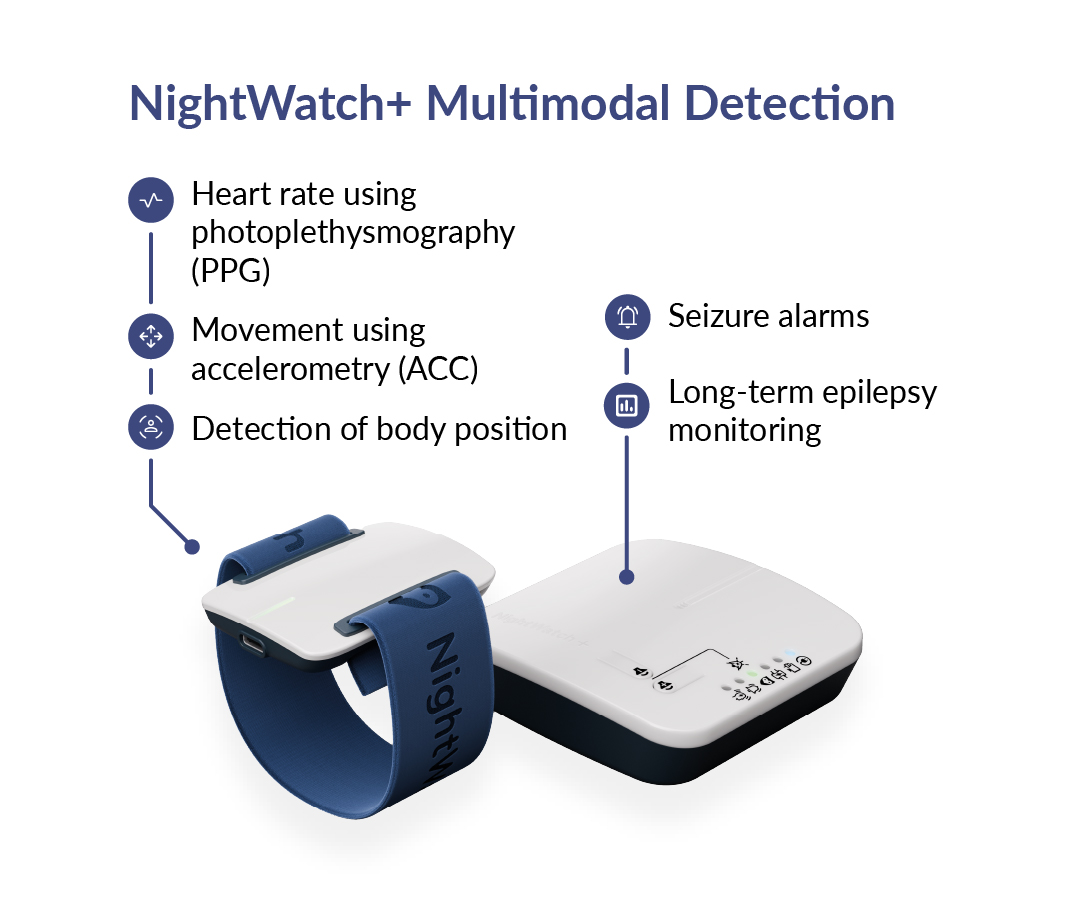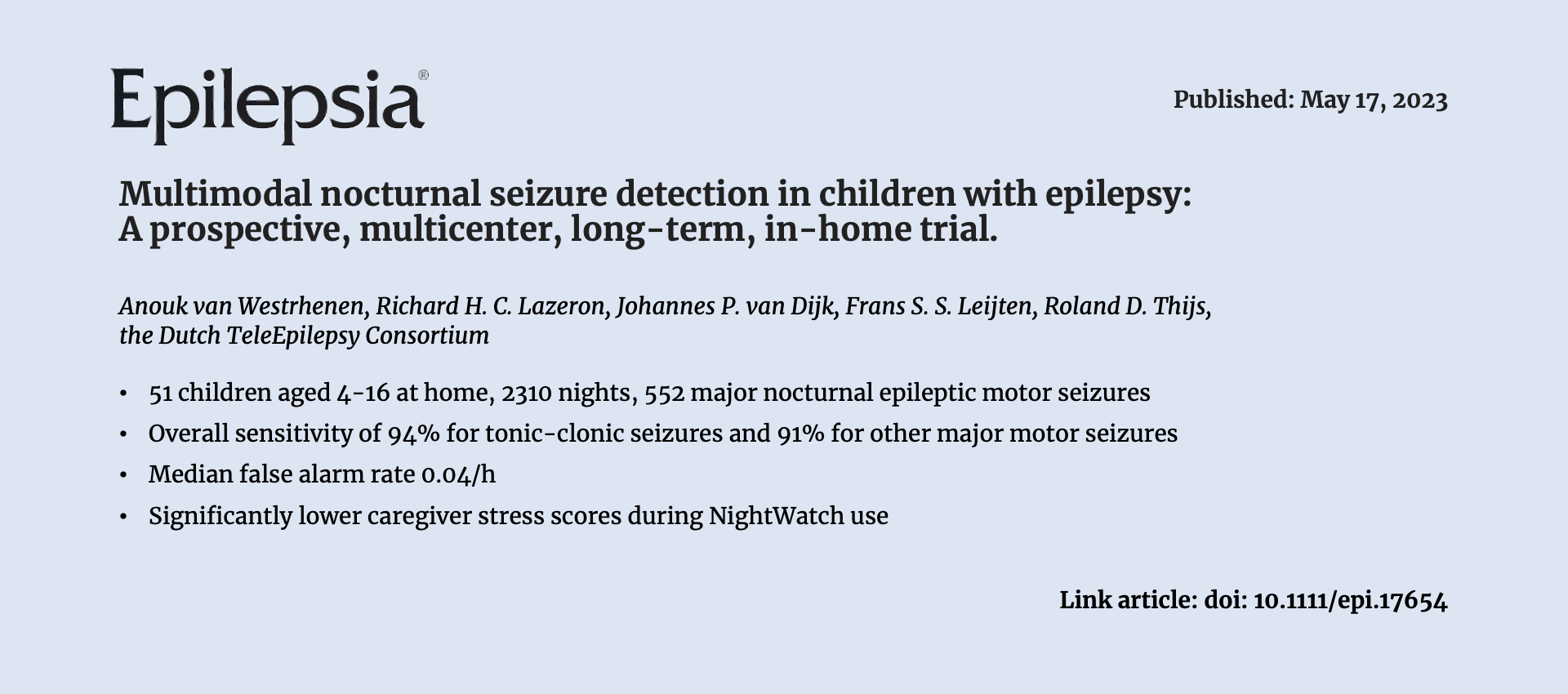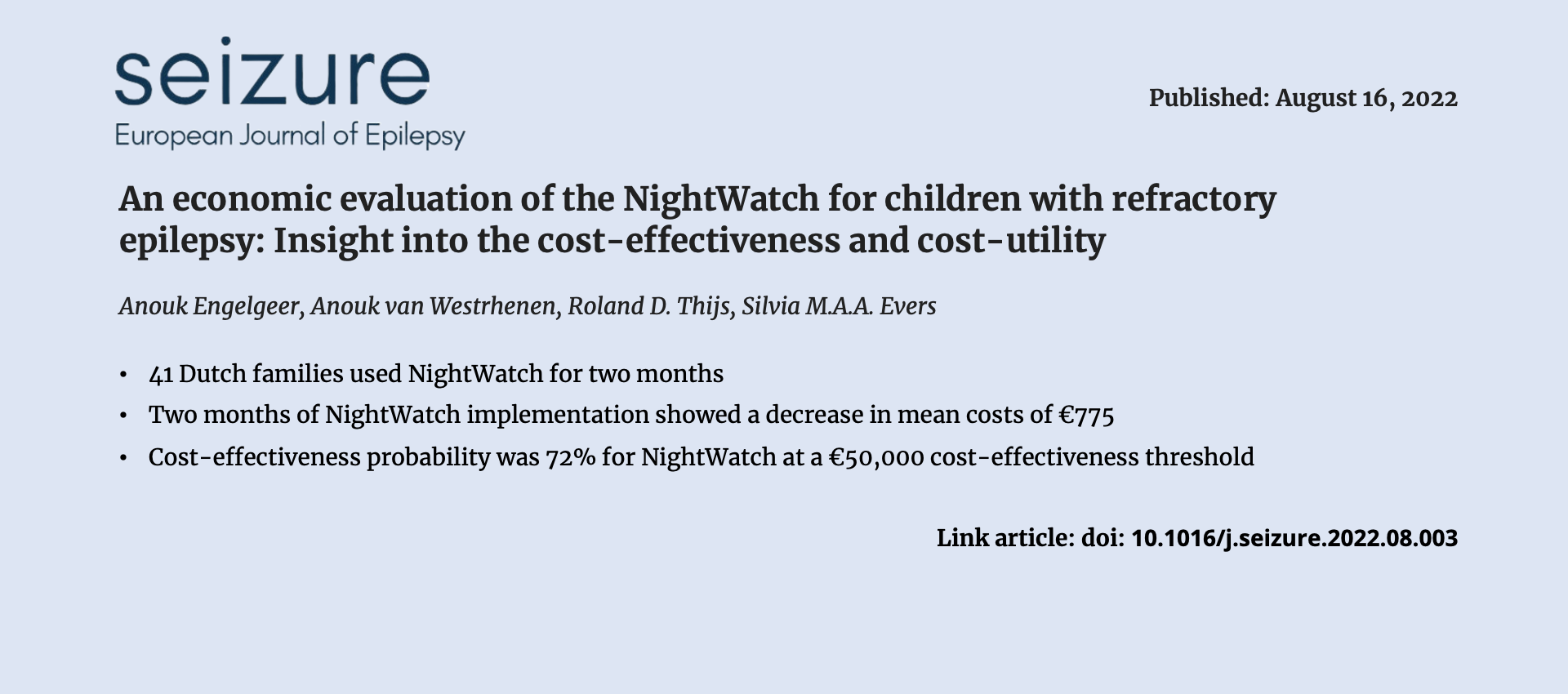Scientific evidence
Research
NightWatch+ originates from decades of conjoined research by the Dutch TeleEpilepsy consortium.
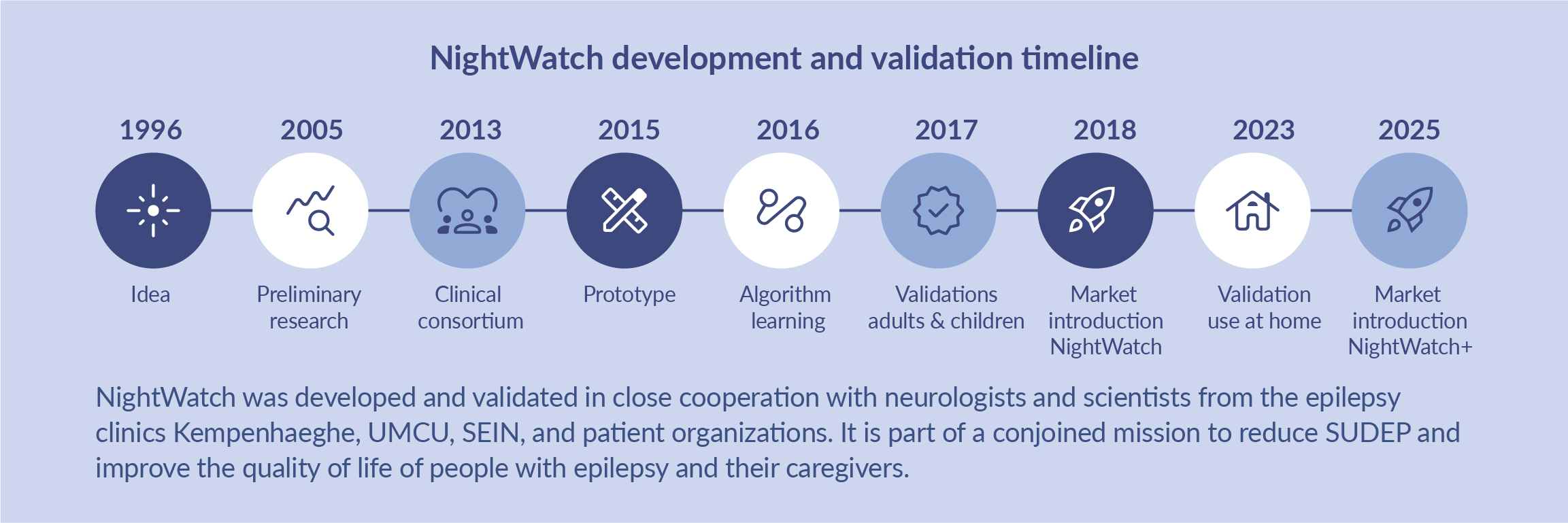
- Tonic-clonic seizures
- Tonic seizures (clustered or prolonged)
- Hyperkinetic seizures
- Myoclonic seizures (clustered)
Multimodal Seizure Detection
NightWatch detects nocturnal epileptic motor seizures by tracking changes in heart rate and specific movement patterns through a wearable sensor. It uses advanced PPG for heart rate tracking and a 3D accelerometer for body position and movement. The detection algorithm is optimized using long-term data from adults and children (> 4 years of age) with thousands of nighttime seizures, validated against video recordings as the reference standard.
Validated Detection Performance
NightWatch’s detection performance has been validated through multiple multicenter trials in realistic home settings, using video annotation as the reference standard, and conducted by trained nurses. This study design allowed evaluation over extended periods where continuous EEG was not feasible. To minimize biases from missed seizures, caregivers documented observed seizures, while automated tools like bed sensors and video analysis supported detection, with trial nurses randomly screening 5%-10% of recordings for additional verification.
The studies demonstrated median sensitivities of 86% for adults and 100% for children for all major motor seizure types, 96% for adults, and 100% for children (> 4 years of age) specifically for tonic-clonic seizures. The average false alarm rate was approximately 0.04 per hour. The false alarm rates strongly varied among users, and many false alarms were, in fact, minor seizures that did not qualify as nocturnal motor seizures.
Other relevant publications on NightWatch or its working principles
- Zelano, J., Beniczky, S., Ryvlin, P., Surges, R., Tomson, T., & the ILAE SUDEP Task Force. (2023). Report of the ILAE SUDEP Task Force on national recommendations and practices around the world regarding the use of wearable seizure detection devices: A global survey. Epilepsia Open. doi.org/10.1002/epi4.12801
Summary:
The article “Report of the ILAE SUDEP Task Force on national recommendations and practices around the world regarding the use of wearable seizure detection devices” examines global recommendations and practices concerning the use of wearable devices for seizure detection. It highlights the importance of these technologies in monitoring seizures and their potential to enhance patient safety. The article mentions that NightWatch has been clinically tested in the Netherlands and is used in epilepsy care. The device has contributed to increased patient safety and improved nighttime monitoring. - Hadady L, Klivényi P, Fabó D, Beniczky S. Real-world user experience with seizure detection wearable devices in the home environment. Epilepsia. 2022;00:1–6. doi: 10.1111/epi.17189
Summary:
The article examines the practical usability and effectiveness of wearable seizure detection devices in a home setting. It highlights the general feasibility and benefits of automated seizure detection at home, which can contribute to improved monitoring and safety for patients with epilepsy. - van Elmpt WJC, Nijsen TME, Griep PAM, Arends JBAM. A model of heart rate changes to detect seizures in severe epilepsy. Seizure. 2006;15(6):366–75. doi: 10.1016/j.seizure.2006.03.005
Summary:
The article explores using heart rate changes to detect seizures in patients with severe epilepsy. It developed two algorithms to monitor heart rate patterns, identifying significant changes like tachycardia and bradycardia during seizures. The study found that heart rate changes occurred in most patients. It concluded that heart rate changes can be used for automatic seizure detection, provided the model parameters are tailored to individual patients. - Massé F, Penders J, Serteyn A, van Bussel M, Arends J. Miniaturized wireless ECG-monitor for real-time detection of epileptic seizures. WH’10. 2010 Oct; 111-117. doi: 10.1145/1921081.1921095
Summary:
The article highlights the feasibility of using heart rate changes as indicators for seizure activity, offering a non-invasive method for monitoring patients with epilepsy. - Lamberts RJ, Thijs RD, Laffan A, Langan Y, Sander JW. Sudden unexpected death in epilepsy: People with nocturnal seizures may be at highest risk: Nocturnal Seizures as a Risk for SUDEP. Epilepsia. 2012;53(2):253–7. doi: 10.1111/j.1528-1167.2011.03360.x
Summary:
The article investigates the association between nocturnal seizures and the risk of sudden unexpected death in epilepsy (SUDEP). The study suggests that individuals experiencing seizures during sleep may have an increased risk of SUDEP. These findings underscore the importance of preventive measures, which may include nighttime monitoring and interventions to reduce seizure frequency during sleep. - van Andel J, Leijten F, van Delden H, van Thiel G (2015) What Makes a Good Home-Based Nocturnal Seizure Detector? A Value Sensitive Design. PLoS ONE 10(4): e0121446. doi: 10.1371/journal.pone.0121446
Summary:
The study investigates the development of a device for in-home detection of nocturnal seizures in patients with severe epilepsy. It identifies five key values: health, trust, autonomy, accessibility, and reliability. These values were then linked to design choices for the device. - Arends JB, van Dorp J, van Hoek D, Kramer N, van Mierlo P, van der Vorst D, et al. Diagnostic accuracy of audio-based seizure detection in patients with severe epilepsy and an intellectual disability. Epilepsy Behav. 2016;62:180–5. doi: 10.1016/j.yebeh.2016.06.008
Summary:
The study evaluates the use of audio monitoring for detecting major seizures in patients with severe epilepsy. It suggests that audio-based detection could be used alone or in combination with other systems for better seizure monitoring. - van Andel J, Thijs RD, de Weerd A, Arends J, Leijten F. Non-EEG based ambulatory seizure detection designed for home use: What is available and how will it influence epilepsy care? Epilepsy Behav. 2016;57:82–9. doi: 10.1016/j.yebeh.2016.01.003
Summary:
The article reviews existing non-EEG seizure detection systems suitable for home use. It evaluates various devices and algorithms, discussing their potential impact on epilepsy management. The study emphasizes the importance of these technologies in enhancing patient safety and monitoring outside clinical settings. - van der Lende M, Cox FME, Visser GH, Sander JW, Thijs RD. Value of video monitoring for nocturnal seizure detection in a residential setting. Epilepsia. 2016;57(11):1748–53. doi: 10.1111/epi.13558
Summary:
Conducted in a residential care facility, the research found that video Monitoring significantly increased the identification of seizures requiring clinical intervention. The study concluded that Video monitoring is a valuable tool for enhancing patient safety and improving the management of nocturnal seizures in such settings. - van Andel J, Ungureanu C, Arends J, Tan F, Van Dijk J, Petkov G, et al. Multimodal, automated detection of nocturnal motor seizures at home: Is a reliable seizure detector feasible? Epilepsia Open. 2017;2(4):424–31. doi: 10.1002/epi4.12076
Summary:
The study investigates the feasibility of using non-electroencephalographic (non-EEG) signals—specifically heart rate and accelerometry—to detect various types of nocturnal seizures, including tonic, tonic-clonic, hypermotor, and clusters of short myoclonic/tonic seizures. The research involved monitoring patients during diagnostic video-EEG examinations. The findings suggest that automated seizure detection using these non-EEG signals is feasible and could enhance patient safety by enabling timely interventions. - Geertsema EE, Thijs RD, Gutter T, Vledder B, Arends JB, Leijten FS, et al. Automated video-based detection of nocturnal convulsive seizures in a residential care setting. Epilepsia. 2018;59:53–60. doi: 10.1111/epi.14050
Summary:
The study evaluates the effectiveness of a video-based algorithm for detecting nocturnal convulsive seizures in individuals with epilepsy residing in a care facility. The algorithm analyzes group velocity signals derived from video sequences to identify seizures. The study concludes that this automated system is effective for real-time seizure detection in residential care settings, potentially enhancing patient safety.
NightWatch for clinical trials
Elevate your clinical trials with high-quality, long-term sleep data collected with minimal burden on patients. NightWatch provides access to key metrics such as PPG, movement data, and seizure frequency over time, supporting diverse research needs through:
- NightWatch Data Portal
- NightWatch Data API
- NightWatch Research Kit
NightWatch Data Portal
The online data monitoring platform allows users to annotate seizures, add information, and access detailed data on recorded HR and movement during sleep. Available to all standard NightWatch users, it offers a simple, low-barrier way to track seizure data over time.
NightWatch API
The NightWatch Data API enables integration with third-party research platforms or digital seizure diaries, allowing real-time collection of nocturnal seizure alarms, heart rate data, and movement patterns during sleep.
NightWatch Research Kit
The plug-and-play research kit is designed for home or institutional use in clinical and research projects. It enables long-term, objective collection of nocturnal seizure data, including:
- Seizure Alarms: Time-stamped seizure alarms for:
– Tonic-clonic seizures
– Tonic seizures (clustered or prolonged)
– Hyperkinetic seizures
– Myoclonic seizures (clustered) - Raw PPG Data: Beat-to-beat heart rate tracking
- XYZ Accelerometer Data: Movement tracking
- Body Position Data
- Video Monitoring: High-quality IR camera with continuous video and audio recording, enabling clinical seizure annotation using the video as the reference standard.
Kit Features
The NightWatch Research Kit is housed in a lockable, portable box with wheels and includes:
- NightWatch device
- Integrated PC with external hard drive
- 4G router for remote access
- Multiple external relay or LAN connections for additional devices
- IR night vision camera
- Active cooling system
-
-
All data is stored locally and can be accessed remotely via LAN or 4G if needed.
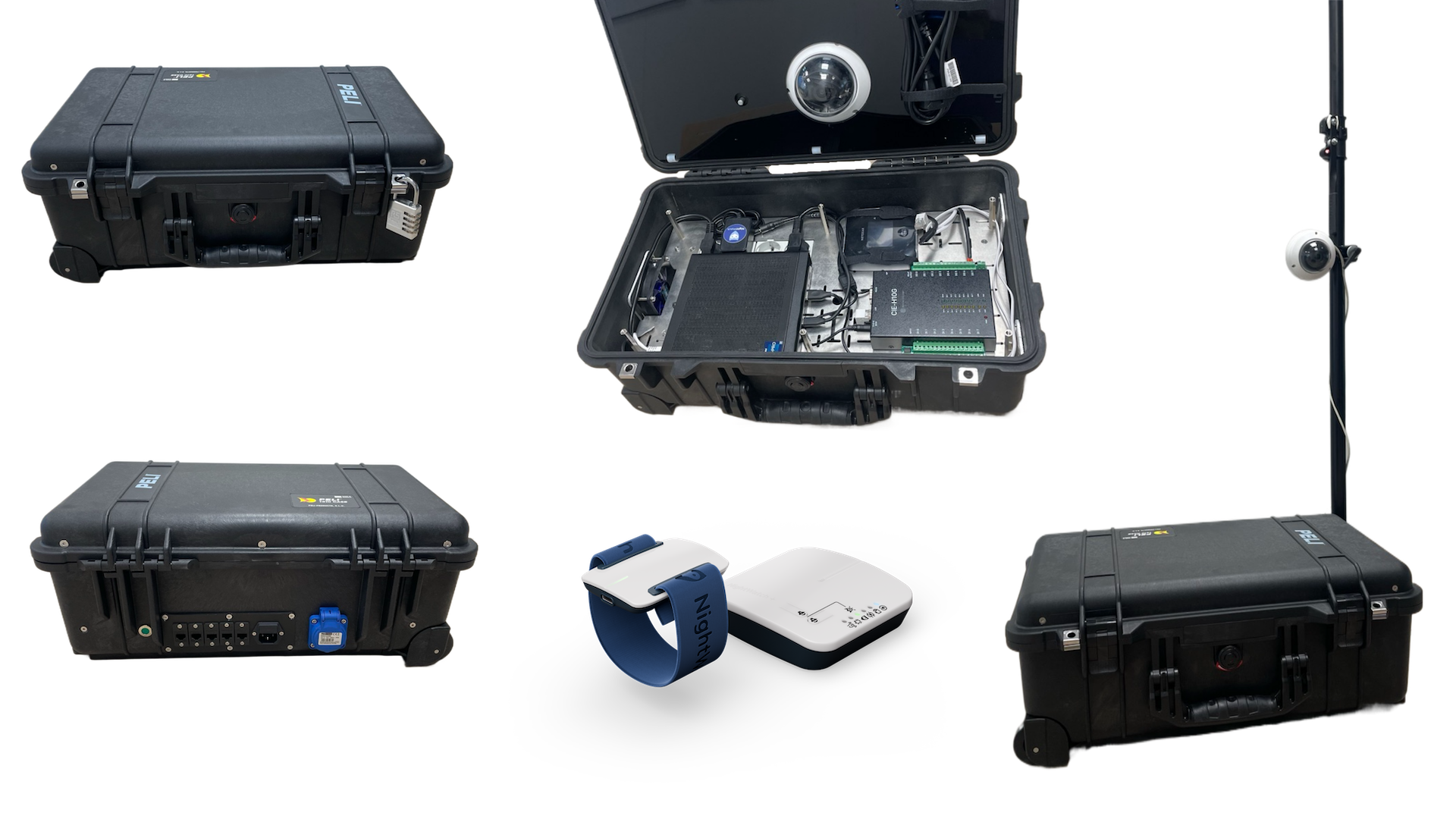
Contact:
For more information on availability and pricing, email info@nightwatchepilepsy.com
Cited literature
- Arends J, Thijs RD, Gutter T, Ungureanu C, Cluitmans P, van Dijk J, et al. Multimodal nocturnal seizure detection in a residential care setting: A long-term prospective trial, Neurology. 2018 Nov 20; 91(21):e2010-e2019. doi: 10.1212/WNL.0000000000006545
- Beniczky S, Wiebe S, Jeppesen J, Tatum WO, Brazdil M, Wang Y, et al. Automated seizure detection using wearable devices: A clinical practice guideline of the International League Against Epilepsy and the International Federation of Clinical Neurophysiology. Epilepsia. 2021 Mar; 62(3):632-646. doi: 10.1016/j.clinph.2020.12.009.
- Lazeron RHC, Thijs RD, Arends J, Gutter T, Cluitmans P, van Dijk J, et al. Multimodal nocturnal seizure detection: Do we need to adapt algorithms for children? Epilepsia. 2022; 7(3):406–13. doi: 10.1002/epi4.12618
- van Westrhenen A, Lazeron RHC, van Dijk JP, Leijten FSS, Thijs RD, the Dutch TeleEpilepsy Consortium. Multimodal nocturnal seizure detection in children with epilepsy: A prospective, multicenter, long‐term, in‐home trial. Epilepsia. 2023. doi: 10.1111/epi.17654
- Engelgeer A, van Westrhenen A, Thijs RD, Evers SMAA. An economic evaluation of the NightWatch for children with refractory epilepsy: Insight into the cost-effectiveness and cost-utility. Seizure. 2022;101:156–61. doi: 10.1016/j.seizure.2022.08.003
